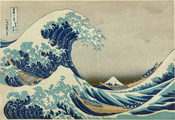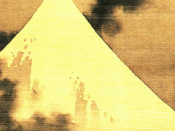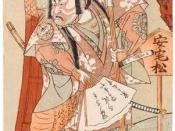The Edo Peroid & Ukio E
Katsushika Hokusai was born in 1760, half-way through the Edo period (1603 - 1868) in Japan. He was born into one of the four classes in Japan (Samurai, then peasants, artisans and merchants); Hokusai was destined to become an artist. Ukiyo-e was at the time the most popular form of art in Japan. It involves woodblock printing in a very simple way; excluding such western principles such as perspective. The word Ukiyo-e is a pun on the Buddhist word for 'suffering world' which is also pronounced ukiyo. Literally translated Ukiyo-e means 'pictures of a floating world'.
Buddhism believes in a world above our own, in which everything is perfect, in the western world it is known as nirvana. This idea was particularly important in the Edo period when Japan was undergoing a cultural revolution. In 1633 the reigning Shogun, Iemitsu isolated Japan from the rest of the world by forbidding all travel and trade abroad.
By 1639 the ban was lifted to a small amount of trade with China and the Netherlands from Nagasaki port. Even after the embargo was loosened, any form of overseas culture such as books, poetry or art weren't allowed into Japan. This caused the Japanese to embark on a cultural upheaval within their society.
The working class were finally given some power and wealth and art became commonplace in many peoples homes. Unlike modern society, religion was still extremely important, and the first recorded Ukiyo-e prints came from temples with pictures of deities or sections of sacred 'sutras'. In Edo Japan the Kabuki theatre was the equivalent of movies & TV today. These plays provided an opening for the first mass production of artwork in history. The posters advertising the Kabuki theatre were rolled off by the hundreds using...


